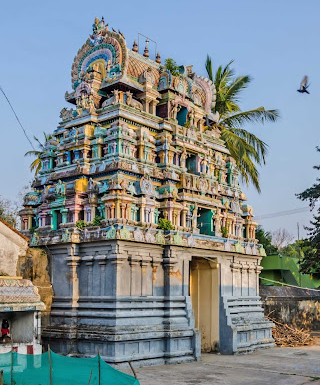During their exile, the Pandava brothers stayed in this area for a time but struggled to find Shivalingas for worship. In their devotion, they lit lamps using Iluppai nuts and meditated on the Lord. In response to their prayers, the Lord granted them individual darshans and appeared as five Shivalingas, fulfilling their request. This is why the temple features five Lingas (Pancha Linga’s) housed in separate shrines.
Puranic Significance :
In ancient times, the region around the temple was believed to be densely covered with Iluppai trees, which is reflected in the temple's “sthala vruksham” (sacred tree). This gives the place its name, Iluppaipattu. The temple is situated on the southern banks of the Manniyaru River, also known as the Subramanya River, leading to the alternate name "Pazha Manni Padikkarai" (“pazha” meaning ancient, “Manni” referring to the river, and “Padikkari” meaning riverbank in Tamil).
Several stone inscriptions found here date back to the time of Chola King Rajaraja and rulers from the VijayaNagara dynasty. The historical names of this place include Madhookavanam and Pazhamanni Padikkarai, and the temple is under the administrative control of the Thiruvavaduthurai Adheenam.
According to legend, during their exile, the Pandava brothers stayed in this area. Duryodhana is believed to have poisoned the Brahma Theertham (sacred water) of this temple, but Goddess Parvathi intervened, removing the poison and replacing it with celestial nectar. Lord Shiva then consumed the extracted poison to save the Pandavas. The tank is known as “Nachupoigai,” meaning poison pond. Goddess Parvathi is praised here as “Sri Amirtha Kara Valli” (meaning "Goddess with nectar hands").
The Pandavas reportedly extracted oil from the seeds of the Iluppai tree to light lamps in the temple. Impressed by their meditation, Lord Shiva granted each of them individual darshans. Each brother requested that the Lord remain in this place to bless all devotees, leading to the appearance of five Shivalingas at different locations within the temple complex. These Lingas are named as follows:
- Sri Neelakandeswarar with Amudhakara Valli worshipped by Dharumar
- Sri Padikkarai Nathar with Goddess Mangalambikai worshipped by Arjunan
- Sri Mahadeshwara worshipped by Bheeman
- Sri Parameswarar worshipped by Nakulan
- Sri Muktheeswarar worshipped by Sakadevan
Another legend involves a Chola king who, while crossing the Manniyaru River by boat to reach the temple, saw an uprooted Iluppai tree floating. He brought the tree to the temple, believing that the oil from its seeds could be used for lighting lamps. A beautiful sculpture depicting this incident can be seen on the outside wall of the sanctum sanctorum. It is believed that the Pandavas, Lord Brahma, King Manthatha, and Emperor Nalan worshipped the Lord here.
